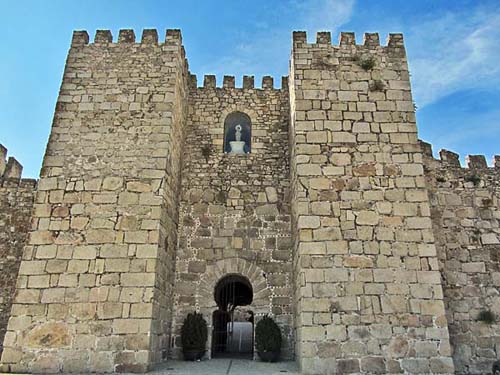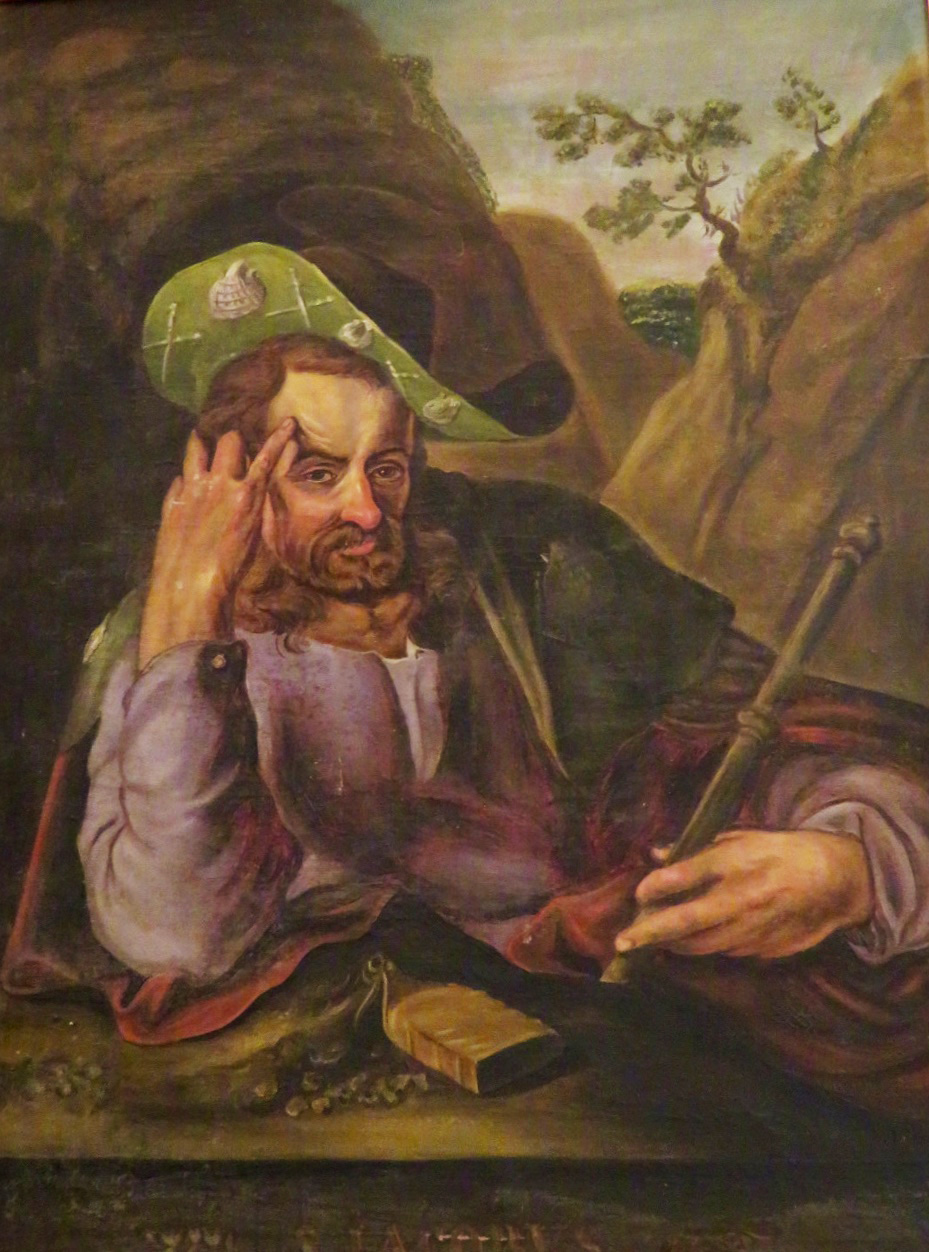Spain’s “Moor-slaying” Ethos
by Guido Mina di Sospiro (June 2018)
Santiago as the Wanderer, artist unknown (from the Museum of the Cathedral of Astorga)
Reconquista, the Re-conquest, which, after eight hundred centuries of constant fighting, led to the expulsion of the Moors from the Iberian Peninsula.
.jpg)
King Pelayo (L) and The Virgin of Covadonga (photos: Stenie Mina di Sospiro)
Reconquista began.”
While Alfonso VIII began to test the resistance of the Moors in the area, it was Fernando III “el Santo” the monarch who, in 1232, re-conquered Trujillo to the Christian faith thanks to a supernatural intervention: the Virgin, holding baby Jesus in her arms, appeared above the walls of the Moorish castle situated at the highest point in town, and thereafter the battle was won by Fernando III’s soldiers. From that moment on, the whole army addressed the Virgin with the title “La Victoria” (The Victory), as the patron saint and advocate of the Reconquista. She was enthroned on top of the main door that leads into the castle, and a chapel in it was created for her.

Our Lady of the Victory (La Virgen de la Victoria) at Trujillo (Stenie Mina di Sospiro)
Ferdinand III “the Saint” (el Santo)—King of Castile from 1217 and King of León from 1230 as well as King of Galicia from 1231—was one of the most effective military leaders in the Reconquista. He was also a pious man, ever willing to ascribe his victories against the “infidels”, be they military or diplomatic, to God or, as illustrated, to the Virgin. Centuries after his death, Pope Clement X canonized him. The San Fernando Valley, near Los Angeles, in Southern California, is named after him.
The patron saint festivities in honor of Our Lady of Victory are held to this day in Trujillo between the end of August and the beginning of September. At the same time, there are festivals of music, dance, and theater. The small town comes alive and attracts visitors from all over the region. 786 year after Our Lady of Victory helped the Spaniards defeat the Moors and re-conquer the city, her memory lives on in a very tangible way. An outsider would think of either Pizarro or de Orellana as being chosen by the town to sing its own glory. To be sure, much is made about them and the Conquistadors, but the chapter pertaining to the Reconquista, with the intervention of Our Lady of Victory, no less, still is the one that is celebrated, and felt, the most.
Like Trujillo, Zamora, in Castilla y León on the banks of the Duero, is another town unlikely to be visited by hordes of tourists speaking mysterious languages. When we were there, we only came across Spanish visitors, and a very few from nearby Portugal. And yet, Zamora is both a gem and a highly emblematic oddity. It numbers twenty-four churches from the 12th and 13th century, all in Romanesque style, as well as some other non-religious buildings in the same style. No other city in the world is graced with as many Romanesque churches—they are everywhere. There is even a diminutive one (not quite) in the center of the plaza mayor.
.jpg)
Some of the many Romanesque churches in Zamora (Stenie Mina di Sospiro)
Catedral de Zamora
Catedral de Santiago de Compostela
celebrate my fortieth birthday and go to a mythical place I’d always wanted to see, I too had embarked on the pilgrimage to St James’s Cathedral, in Santiago de Compostela, with my wife. It’d been an incredible fifty yards, from the hotel straight to the cathedral, nonstop and all on foot despite the inclemency of the weather: a drizzle.” Notwithstanding my levity, Santiago de Compostela is one of the most important shrines in Christendom, and far and away the most celebrated pilgrimage in the western world. Tens of thousands of pilgrims of all nationalities and all faiths (including none) trudge every year along the Camino de Santiago, from France, or Portugal, or elsewhere in Spain, hundreds of kilometres on foot. If they make it, they eventually reach the Praza do Obradoiro (the Square of the [completed] Work of Gold, an appellation with distinct alchemical overtones), where the grandiose Cathedral stands. Many if not most pilgrims are shocked when, once inside the cathedral, they come across a statue of Santiago (St. James) mounted on a white horse and wielding a sword. Little do they know that behind the greenery providentially placed there by decision of the Catholic Church, are the statues of writhing Moors on the ground being slaughtered by the saint. The iconography of Santiago all pilgrims become familiar with along the way is that of the prototypical wandering hippy, bearded and understandably a little dishevelled, with a walking stick, a large hat and the distinctive scallop on it (which the French call coquille Saint-Jacques, precisely). He looks straight out of a hippy commune in the late 1960s. Inside the cathedral, on the other hand, the contemporary pilgrims meet with that other Santiago—Matamoros, literally, St. James the Moor-slayer.
James was one of the twelve apostles of Jesus and is considered the first apostle to be martyred. He is the patron saint of both Spaniards and Portuguese, respectively called Santiago or São Tiago. His myth as a warrior on the side of the Christians against the Muslims derived from what seems to be a fictional battle allegedly fought near Clavijo between the Christians, led by Ramiro I of Asturias, and the Muslims, led by the Emir of Córdoba. In it, Santiago Matamoros (the Moor-slayer) appeared suddenly and helped an outnumbered Christian army to gain victory. The date assigned to the battle, 834, was later changed to 844 to suit more plausible historical details.
history of the Reconquista, and incarnates one of most formidable ideological icons in Spain’s national identity. “¡Santiago y cierra, España!” and that is, “Santiago and close, Spain!” or “Santiago and at them, Spain!” became the battle cry of Spanish armies when fighting against the Moors (and continued to be used, later on, by the Conquistadors, with Santiago Matamorors morphing opportunely into Santiago Mataindios [Indian-slayer], but that’s another story). The Orden de Santiago, i.e., the Order of St. James of the Sword, was founded in the 12th century. Its aim was to protect the pilgrims of the Camino de Santiago, to defend Christendom, and to expel the Moors from the Iberian Peninsula. Its emblem was the cruz espada, the Cross of St. James, and that is, a cross that looks very much like a sword. Lastly, Santiago was a major theme in the arts, in paintings and sculptures alike, and is found in countless churches, palaces and museums all over contemporary Spain.
Upon entering at long last the overwhelming cathedral of Santiago the Compostela, most pilgrims are astonished to see Santiago transformed from the prototypical wanderer to a sword-wielding Moor-slayer. In 2004, shortly after the Madrid train bombings (or 11-M), the Al-Qaeda terrorist attack that killed 192 people and injured around 2,000, the Catholic Church decided to remove the statue of Santiago Matamoros from the cathedral, not to offend the sensitivity of Muslims (belatedly?). There was a popular uproar against such a removal, and the compromise was found of covering the slain Moors with greenery, which is kept up to this day. Pilgrims, be they Catholics, agnostics, humanitarians or politically correct hypertolerant globalists feel that nothing could be more contrary to the teachings of Jesus than the idea that one of his disciples would be glorified as a murderer. Nobody must have told them about St. Bernard of Clairvaux’s letter to the Templars, or Liber ad milites templi de laude novae militiae (Book to the Knights of the Temple, in Praise of the New Knighthood), written between 1120 and 1136.
St. Bernard wrote that letter/book for the demoralized Knights Templar, who were having serious doubts about the role of Christian warriors, and especially about the act of killing, which they deemed unethical. Displaying his eloquence, and starting from the premise of Augustine of Hippo’s just war theory (jus bellum iustum), St. Bernard introduced in his book the concept of mali-cidium (the killing of evil). The Milites Christi, the warriors of Christ, could not commit homi-cidum (homicide, literally the killing of man), which is forbidden by the fifth commandment. But since the higher good of the eradication of evil demanded it, the malicidium within the Muslim “infidel” (the killing of evil inside him) was justified.
While the Catholic Church was busy keeping its curtains of greenery around the base of the statue of Santiago Matamoros, there occurred the Barcelona Attacks, that killed 13 people and injured at least 130 others, whose indirect responsibility was attributed to the Islamic State of Iraq and the Levant (ISIL).
Given its past, given the fact that the Reconquista is vividly commemorated to this day all over the country and its fundamental significance inculcated into the minds of all citizens starting with elementary school children, do you find the western political correctness trespassing into tolerance à outrance well- or ill-suited to Spain?
_______________________________
Guido Mina di Sospiro was born in Buenos Aires, Argentina, into an ancient Italian family. He was raised in Milan, Italy and was educated at the University of Pavia as well as the USC School of Cinema-Television, now known as USC School of Cinematic Arts. He has been living in the United States since the 1980s, currently near Washington, D.C. He is the author of several books including, The Story of Yew, The Forbidden Book, and The Metaphysics of Ping Pong.
More by Guido Mina di Sospiro.
Follow NER on Twitter @NERIconoclast
